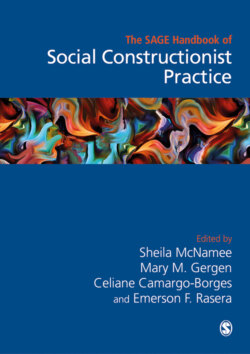Читать книгу The Sage Handbook of Social Constructionist Practice - Группа авторов - Страница 127
На сайте Литреса книга снята с продажи.
Transmaterial Research Questions
ОглавлениеTransmaterial worlding as inquiry asks investigative questions such as:
‘How can we show what matters, how it matters, and to whom it matters?’
‘How can we show others what is being constructed, how and with whom?’
‘How can we use our understanding of communication to show how relations in the world are being created?’
The how can we show questions are not innocent or decontextualised research questions. They reflect some anxiety that facts and findings alone will not be accepted as evidence. They anticipate an increasingly sceptical audience. Members of the public see politicians fighting with scientists over who is telling the truth. Black and indigenous communities struggle to have their realities of systematic and institutionalised abuse taken seriously by those in positions of influence. Evidence using what was traditionally considered robust research methods is no longer enough. On the one hand, methods often reproduce colonising values that serve to reproduce material which does not reflect lived experience, for example, of oppressed and minority peoples. On the other hand, approaches that do reflect experiences of minority or oppressed peoples are often critiqued for being too subjective and insufficiently rigorous.
These questions then also need including to address the voices of human and also of non-human life forms.
‘How is material being defined?’
‘Which voices are being included or excluded?’
‘How are they represented?’
‘What negotiations are involved in the process of knowledge generation and knowledge sharing?’
There are different kinds of power to consider in transmaterial worlding as a method of inquiry:
1 The power to influence how people configure realities through discourse and narrative;
2 The power to create structures which solidify and embody those realities;
3 The power to deconstruct and reconstruct material and linguistic structures;
4 The power to recognise that truths are not representative of one's own, other people's or the material environment's experience;
5 The power to deliberately seek out first person experience and alternative truths.
In order for research to make a difference, researchers need to ask
‘What are the governing contexts that have given rise to such a problem?’
‘How are imbalances of power maintaining this problem?’
‘How can this research disrupt the power relations that prevent social-justice-driven change?’
‘Which voices need to be heard and how can we extend what we can hear and see?’
‘Who is best placed to represent issues and how and with what support?’
Social constructionist research needs to draw on systemic and posthuman understandings of context and power to explain
1 Why change is difficult to effect;
2 Why challenging the social construction of language is in itself not going to result in systemic change, desirable, sustainable change over tokenistic gestures;
3 How to create change and why it might be difficult.
Using questions such as these, transmaterial worlding offers a form of inquiry which integrates a concern for the ecology of the planet into the concept of social.
